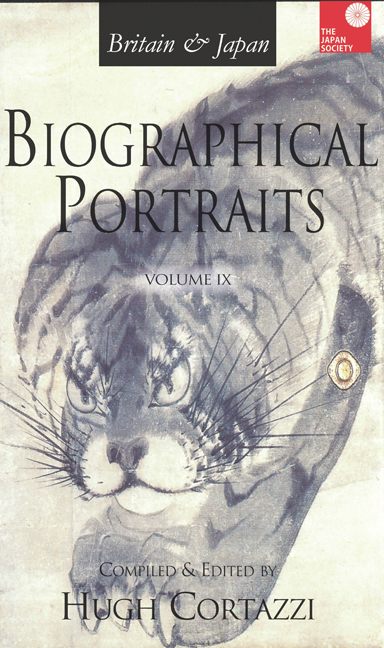Book contents
- Frontmatter
- Contents
- Introduction
- List of Contributors
- Index of Biographical Portraits in Japan Society Volumes
- PART I JAPAN IN BRITAIN: THINGS JAPANESE
- PART II BRITAIN IN JAPAN: TRADE
- BRITISH ACTIVITIES
- MISSIONARIES
- MUSIC, DRAMA AND FILM
- EPISODE
- PAINTERS
- JOURNALISTS
- JAPANESE WOMEN PIONEERS
- PART III SCHOLARS AND WRITERS: JAPANESE
- BRITISH
- PART IV POLITICIANS AND OFFICIALS: JAPANESE
- BRITISH OFFICERS
- BRITISH JUDGES AND A DIPLOMAT
- BRITISH POLITICAL FIGURES
- Index
25 - Alfred Parsons, RA, PRWS (1847-1920) and the Japanese Watercolour Movement
Published online by Cambridge University Press: 30 April 2022
- Frontmatter
- Contents
- Introduction
- List of Contributors
- Index of Biographical Portraits in Japan Society Volumes
- PART I JAPAN IN BRITAIN: THINGS JAPANESE
- PART II BRITAIN IN JAPAN: TRADE
- BRITISH ACTIVITIES
- MISSIONARIES
- MUSIC, DRAMA AND FILM
- EPISODE
- PAINTERS
- JOURNALISTS
- JAPANESE WOMEN PIONEERS
- PART III SCHOLARS AND WRITERS: JAPANESE
- BRITISH
- PART IV POLITICIANS AND OFFICIALS: JAPANESE
- BRITISH OFFICERS
- BRITISH JUDGES AND A DIPLOMAT
- BRITISH POLITICAL FIGURES
- Index
Summary
INTRODUCTION
ALFRED WILLIAM PARSONS was an English painter, illustrator and garden designer, who is now only marginally remembered in Britain, but played a catalytic role in the flowering of Japanese watercolour painting during the late nineteenth and early twentieth century.
Parsons was born in Beckington, Somerset, in 1847. In 1862 when he was fifteen, he toured to France, Switzerland and Italy. Around 1865 he moved to London and attended South Kensington Schools in the evenings. Initially he worked as a clerk in the Post Office, but in 1867 gave up this post and concentrated on his career as an artist. He started to exhibit regularly at the Royal Academy from 1871 onwards. He became an Associate of the Royal Academy of Arts in 1897 and then a full Academician in 1911. In 1887 his oil painting When Nature Painted All Things Gay was bought for the nation through Chantry Bequest selection.
He painted a number of such oil paintings, but he was better known as a watercolourist. In 1914 he became the President of the Royal Watercolour Society, which was founded in 1804 and is the oldest watercolour society in the world. He continued in this post until his death in 1920. Apart from the Royal Academy and the Royal Watercolour Society he was a member of many societies and showed at numerous exhibiting organizations, among others the Art Workers Guild, Dudley Art Society, the Grosvenor Gallery, the Fine Art Society, Dowdeswell & Dowdeswell and the New English Art Club. He also exhibited internationally, e.g. in Tokyo (1892), St. Louis (1904), Christchurch (New Zealand, 1906–1907), Rome (1911) and New York (1916).
Parsons had an extensive network of friends and acquaintances, which included artists and designers, such as Sir Lawrence Alma-Tadema, Sir Edward Burne-Jones, Sir Luke Fildes, Paul Cesar Helleu, Lord Leighton, William Morris, Arthur Rackham, Linley Sambourne, John Singer Sargent, Marcus Stone, James McNeill Whistler and William Robinson and writers such as Henry James, Vernon Lee and Okakura Kakuzō . He even carried out the floral decoration for the dinner given by the friends of Alma-Tadema in honour of Alma-Tadema's knighthood in 1899. His network was unusually varied ranging from conservative painters such as Alma-Tadema or Fildes to radical designers such as Morris or Robinson.
- Type
- Chapter
- Information
- Britain & Japan Biographical Portraits Vol IX , pp. 284 - 296Publisher: Amsterdam University PressPrint publication year: 2015



